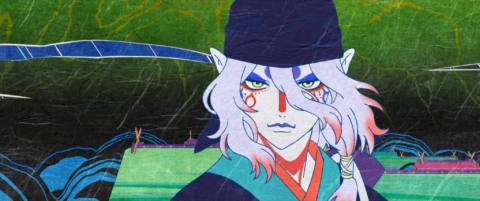
Nobody is more surprised that there are now three Mononoke movies than people who love Mononoke. Being a fan of Kenji Nakamura’s visually gobsmacking, narratively engrossing 2007 anime means constantly, carefully specifying, “No, not Princess Mononoke, just Mononoke. It’s this gorgeous horror mystery anime series. Have you seen it?” — and being ready for the answer “No.”
Mononoke has always been one of those cult miracles: beautiful, praised by those in the know, but finite in its relative obscurity, especially for English-speaking audiences. So the moment I heard that Nakamura was making three new movies — the first of them, Mononoke the Movie: The Phantom in the Rain, premieres for Western audiences on Netflix Nov. 28 — I was fully bought in.

When we award the Polygon Recommends badge, it’s because we believe the recipient is uniquely thought-provoking, entertaining, inventive, or fun — and worth fitting into your schedule. If you want curated lists of our favorite media, check out What to Play and What to Watch.
The Phantom in the Rain is everything I expected from the further adventures of Medicine Seller, the demon-slaying Poirot of the Edo period. The series’ irresistible hook — Japanese ghost stories told in the format of a detective procedural — is back in fine form, as is the TV series’ inimitable visual style, seamlessly updated for modern animation techniques. But the movie is only almost everything I wanted from a Mononoke movie.
What I’d really hoped for was an easy, readily available way to get Mononoke in front of more eyeballs. Regrettably, The Phantom in the Rain is not that. At least, not yet.
The Phantom in the Rain, as usual for Mononoke’s episodic nature, opens with a fresh set of characters. Asa and Kame are two new handmaidens, arriving at the emperor’s Ōoku to spend a lifetime in, or in service to, his harem. Also, as is usual for Mononoke’s episodic nature, our hero, the mysterious demon-slayer and mystery-solver known only as Kusuriuri (literally, “Medicine Seller”), happens to arrive and take an interest in the Ōoku on the very day Asa and Kame are admitted.

The big news is that preparations are underway for a ceremony celebrating the birth of the emperor’s newest child, born to one of his favorite concubines — but no one will explain why that celebration was delayed several months in the first place. Between Asa and Kame being introduced to the strange rituals of the Ōoku, and the tension between visiting samurai investigators, Ōoku matriarchs, and Medicine Seller, there are lots of meaty mysteries to go around. Maybe too many.
The first thing anyone notices about Mononoke the series is its visual design — so colorful, detailed, and textured that it borders on the psychedelic. What’s less evident from a brief glance is how tightly contained each of Mononoke’s mysteries are, and how skillfully Nakamura presents them visually.
Each episode of Mononoke is as intriguing as the best puzzle-adventure game, inviting close observation and rewarding repeat viewing. The show offers hints in the form of shot compositions, symbolism, and cutaways. Nakamura ratchets up the dramatic irony by feeding the audience information that the characters don’t yet realize, assuming the audience is looking closely enough to catch it.
Phantom in the Rain, however, breaks Mononoke’s tradition of fully stand-alone mystery arcs. While it does resolve its central mystery, the story carefully introduces some characters and plot threads — a man who ladles out the cursed water for the handmaidens, hints of palace intrigue beyond the Ōoku — only to leave them dangling, extraneous to the mystery’s solution.
To a longtime fan, it seems clear that Nakamura is laying track for the second and third Mononoke movies to come. But if you haven’t experienced Mononoke’s previous highly self-contained format, you’re just gonna think those dangling threads are messy. “Wait, what about all those shots we got of the ladle guy looking suspicious? Huh. Weird.”

I’ll admit even I wasn’t sure about it until I noticed something — and this is the kind of thing I mean when I say that Mononoke wants your puzzle-level focus. The movie’s end credits play over a single animated loop of a camera rotating around a room with a great altar. The altar is hung with three ropes, each of a different color, but one of them is broken and hangs slack.
I recalled a moment in Phantom in the Rain’s climax, in which Nakamura cuts to a single shot of a rope snapping that doesn’t seem to have anything to do with the rest of the action. Ah, I thought, each rope on the altar is related to one of the three Mononoke movies. They’re all building toward something that will occur, possibly in this room, when the third rope breaks.
And I know that sounds like a leap, but it’s exactly the kind of non-articulated, fully visual foreshadowing that Nakamura has made a habitual part of Mononoke. Phantom in the Rain lives up to the bar set by the original anime series, with a toothy, spooky mystery featuring a suave protagonist, visuals so lush they sometimes border on overwhelming, and the skillful blending of cutting-edge and traditional animation to great effect.
If you’re already a fan of Mononoke, Phantom in the Rain has everything you’re looking for except an easy entry for your newbie friends. If you’re one of those newbies, though, I’d recommend waiting for all three films to be available, so we can see what the whole picture looks like.
Mononoke Second Chapter: Hinezumi premieres in Japan in March 2025. Given the six-month gap between Phantom in the Rain’s Japanese debut and its Netflix release, we probably won’t see it in the U.S. until late 2025. But that gives you plenty of time to catch up on the series first.
